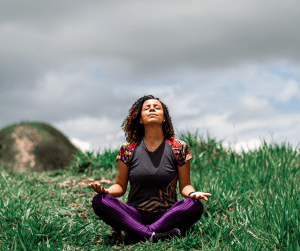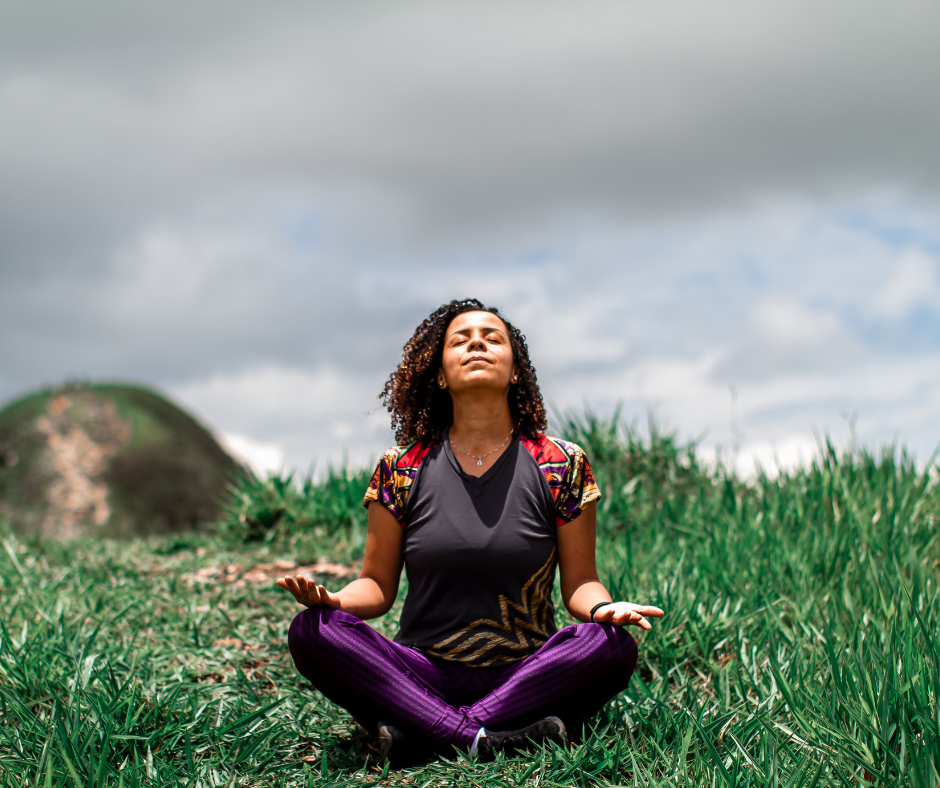Too Much Tension
From as early as my tween years, I struggled with chronic tension headaches. I woke up with headaches, had headaches all day, and went to sleep with headaches. It was unfortunately my norm.
I took way too much Ibuprofen to try to dull the discomfort of the constant throbbing and pressure, but this was only temporary relief and didn’t prevent these nagging headaches. My parents took me to many doctors and did all the testing that the doctors knew how to do. However, they couldn’t find anything that could be causing these daily headaches in an otherwise young, healthy kid. I also struggled with IBS (or chronic belly aches) from an early age, but that’s a whole other post on its own!
Relearning How to Breathe
One doctor recommended biofeedback therapy. “Wait, what?” “So I’m going somewhere so they can teach me how to breathe?” I was skeptical to say the least, but my parents had tried everything and I’m sure were desperate to help me feel better.
From what I can remember, they hooked me up to a machine and I sat there and tried to breathe to follow patterns and games on the computer screen. I went in to my biofeedback appointment with a headache, and left with no headache! The therapist gave me some dot stickers that he told me to stick them on things I see often around my house as a reminder to stop and consciously take a few deep, long breaths.
The breath was powerful, therapeutic, and worked wonders to help keep control of my tension headaches, and eventually I didn’t need the Ibuprofen anymore!
Signals From My Body
I seem to naturally hold a lot of tension in my body, we all do to an extent! But as an anxious, highly sensitive, very driven and type A woman, I put a lot of pressure on myself. That pressure seemed to build and build and create extra stress over time in my body.
I used to have unhealthy ways of dealing with stress (drinking too much alcohol and coffee, stress eating, working out too hard, suppressing my feelings, etc.). I worked too hard without enough breaks and burnt myself out over the years. This eventually showed up in my body as a ton of tension, tightness, discomfort and dis-ease.
My neck was chronically stiff, tight and achy.
My stomach was always in knots, cramped, and clenched.
And my hips felt like I was an 80 year old in a 20 something’s body.
I was even diagnosed with high blood pressure in my 20s.
And I was one of the rare ones that would actually feel the symptoms when my BP increased. It felt like my heart was racing, nervousness, headaches, sometimes dizzy, and my face would feel flush. Slowly but surely, the tension headaches creeped back in as well and my GI issues were only getting worse (chronic discomfort, gas, bloating, and cramping).
Reminder to Refocus on the Breath
It wasn’t until recently that I realized how my breathing significantly impacted not only how I was feeling physically but also my mental health. I’ve learned a LOT over the past 5 or so years on how breathing impacts our health on so many levels. As I’ve been focusing my attention on my own healing journey with Hashimotos, Sjogrens, Interstitial Cystitis, and neurotransmitter imbalances, I remembered what I learned back in biofeedback when I was a kid.
I rediscovered the power of the breath! The more I read and researched about breathing and our health, the more I tuned in to my body and realized I was constantly breathing rapidly, with my mouth open, taking short shallow breaths from my chest. This signaled to my body that it was chronically in fight-or-flight – when the body instinctively takes in more oxygen in an attempt to get ready to defend itself or flee from danger. This type of breathing creates tension in the body and keeps the body in a constant state of stress. Very shallow breathing can be associated with a fear response, often associated with physical or emotional pain.
We Can Control Our Breathing
Stress is a HUGE trigger for most, if not all of my symptoms. And one of the easiest, quickest, and least expensive (FREE) ways to manage stress is to control and optimize our breathing.
Sometimes all we can control is our breath.
Our bodies NEED oxygen for healing. I’m certainly not trying to oversimplify it because my personal health struggles have been complicated to say the least. And the way I was breathing was not necessarily a cause of my conditions, but rather contributed as a trigger to some of my symptoms. My breathing was certainly not the ONLY change I had to make in order to heal. But, learning how to breathe optimally has played a significant role in preventing and relieving certain symptoms such as tension, high blood pressure, headaches, bloating/gas, irritability, and stress. Slow deep (diaphragmatic) belly breathing has helped me to relax and tap into my parasympathetic nervous system (the one responsible for rest and digestion).
As a result, therapeutic breathing techniques are one very valuable tool in my toolbox to better manage pain and discomfort associated with my chronic conditions as well as helping to balance my stress levels, anxiety, emotions and mood.
Our bodies naturally know how to breathe in a way that is healing and relaxing. Think about when you see a baby or young child quiet at rest, they automatically breathe slowly, deeply. You can see their bellies rise and fall steadily with each breath.
As often as I can, I try to practice slow, soothing, relaxing belly-breathing. Taking long, slow deep inhales through my nose, feeling my belly rise as it fills with air… Then releasing the breath gradually as an extended, cleansing exhale.
Breathing Exercises
Here are a couple of easy breathing exercises to incorporate into your routine when you’re feeling stressed, irritable, in pain or just want to feel relaxed.
One technique is 4X4 box breathing (square breathing) – where you alternate breathing and holding your breath for 4 seconds each.
- Sit or stand upright.
- Slowly exhale through your mouth, allowing all oxygen to leave your lungs.
3. Inhale and count slowly to 4 in your head, filling the lungs completely without straining.
4. Hold the breath while counting slowly to 4.
5. Exhale and slowly release the breath to the count of 4.
6. Hold the breath for the count of 4.
7. Repeat this cycle several times.
4-7-8 breathing is a yoga technique called pranayama, developed by Dr. Andrew Weil.
- Part your lips slightly. Make a whooshing sound, exhaling completely through your mouth.
- Close your lips. Inhale silently through your nose as you count to 4 in your head, filling the lungs completely without straining.
- Hold your breath for 7 seconds.
- Exhale and make another whooshing sound from your mouth for 8 seconds.
- Repeat this cycle several times.
“Breathe. Believe. Receive” – Author unknown


















